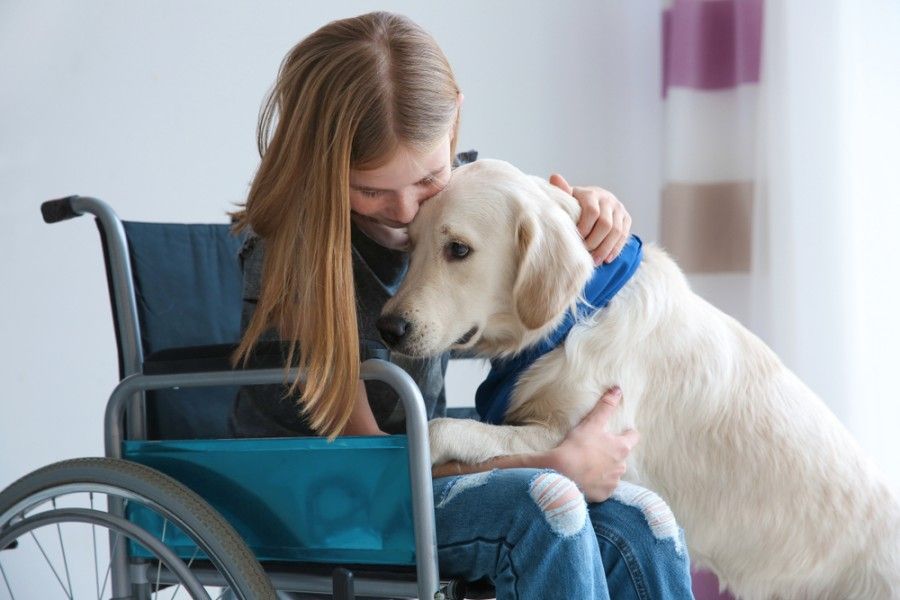10 Interesting Service Dog Statistics (Updated in 2024)

Updated on

Note: This article’s statistics come from third-party sources and do not represent the opinions of this website.
For many people, life would be drastically different without their service dog. Most dog owners value their canine as a member of the family, but for the people who rely on their service dogs for the standard activities of daily life, they’re invaluable.
Service dogs are not pets. They are highly trained to help with specific disabilities in very specific ways. This allows disabled individuals to interact in the world in ways that would otherwise be impossible. For instance, guide dogs can help the blind navigate, acting as their eyes, and mobility dogs can pull individuals in wheelchairs or assist those with balance issues.
Interestingly, any type of dog can become a service dog with proper training, but Retrievers tend to be the most commonly used canines for service work due to their gentle nature, intelligence, and trainability.
Top 10 Service Dogs Statistics
1. Less than 1% of Americans living with disabilities use service dogs
According to the CDC roughly 61 million Americans are living with disabilities. That’s about 26% of the population. But less than 1% about of them are able to work with service dogs due to a mix of availability, costs, and barriers for service animals that still exist today.
2. Approximately 500,000 service dogs are currently helping people in the US
Though service dogs are helping tens of millions of people nationally, there still aren’t nearly enough of them to go around. There are only about half a million service dogs currently helping disabled people in the US. Because of this, it can take a long time for an individual to locate a trained service canine.
3. Currently, there are 14 total schools in the US that are accredited by the International Guide Dog Federation.
Guide dogs help to lead the blind, acting as their eyes. At present, there are 14 schools accredited by the IGDF in North America. A complete list of the US and Canadian locations can be found on their website.

4. Just 2% of blind or visually impaired people work with guide dogs
As we just mentioned, there aren’t enough service dogs to go around. When it comes to the blind and visually impaired, only 2% are currently working with guide dogs. Imagine how many peoples’ lives could be improved by the addition of a guide dog.
5. About 5,000 hearing dogs are currently being used in the US
Of course, blind people aren’t the only ones who are getting canine aid. Deaf people also use dogs to help physically alert them to sounds that they can’t hear. Noises such as fire alarms, alarm clocks, phones ringing, or children crying might seem obvious to most people, but they don’t exist in a deaf person’s world. Unfortunately, just 5,000 hearing dogs are currently working in the US; a far cry from the approximately 1 million individuals who are functionally deaf.
6. 50-70% of canine candidates for service dog positions fail in training
Though any breed of dog can become a service dog, it’s not an easy position to fill. They must pass rigorous standards and prove that they’re healthy, well-trained, obedient, trustworthy, and more. Because of this, only a small percentage of dogs make the cut. Roughly 50-70% of all canine candidates don’t make it and fall out somewhere during the course of training.

7. 48 measures were introduced in 2018 to combat the problem of fake service dogs
Real service dogs are somewhat rare. After all, there are only around half a million legitimate service dogs in the US. But the number of fake service dogs has been growing exponentially. It’s become a major problem for businesses, landlords, and more. So much so that in 2018, 48 measures were introduced in an attempt to put a stop to the fake service dogs.
8. 18 months is the average minimum training time for a service dog
Training a service dog takes a lot of time. They have to learn way more than your basic obedience commands. Service dogs require detailed training on handling specific medical conditions. That training could actually mean the difference between life and death for someone.
9. Training a service dog costs between $10,000 and $20,000
Of course, all that specialized training and the time that went into it isn’t cheap. Service dogs cost tens of thousands to train, but when you consider the 18 months that they undergo training, it’s not that expensive.

10. The average wait time for a well-trained service dog is about 3 years
Naturally, with so many disabled individuals in need of a service dog to help them with their day to day activities, the demand for these useful canines far outweighs the supply. And since it’s so expensive and time-consuming to train a service dog and more than half of all candidates fail, there’s no easy way to solve the problem.
What Are Service Dogs Most Commonly Used for?
Service dogs are viable for helping with just about every disability. According to the Americans with Disabilities Act (ADA), a disability is any physical or mental impairment that limits any major life activity. This includes blindness and vision impairment, deafness, physical disabilities, mental disabilities, and everything in between.
Thankfully, man’s best friend happens to be a very versatile animal that can adapt to helping with many of these disabilities. For instance, guide dogs, one of the most common types of service dogs, are able to act as a blind person’s eyes and lead them around. This helps them to complete everyday activities like getting to the grocery store or the doctor’s office.
Hearing dogs are also very common. They help deaf people by alerting them to important sounds that they’d otherwise miss.
Mobility dogs that help those with physical impairments are also very common. They can pull individuals in wheelchairs, assist people with balance problems, or help those using walking devices.
Medical alert dogs are another common service dog. They can sense medical issues such as low blood sugar in a diabetic, alerting them that it’s time to medicate, or aiding someone when a seizure begins.

What Rights Do Service Dogs Have?
Thankfully, the rights of service dogs and their disabled humans are well-protected by the ADA. Basically, anywhere that people are allowed to go, they can take their service dogs with them. This includes all public areas and facilities and private businesses as well.
However, service dogs can be excluded from places if there are legitimate health or safety concerns. They can also be removed if the disabled individual is unable to keep the dog under control or if the dog is not housebroken.
A disabled individual with a service dog can’t be asked to pay a deposit or surcharge for their service animal, even if other dogs would be required to pay the fees. But disabled individuals are still responsible for their service animals, so they can be charged for any damages that do occur because of their service dog.
Service dogs and their owners are also protected by the Fair Housing Act, which ensures that landlords and housing providers must provide reasonable accommodation for service dogs without discrimination.
What Kind of Breeds Are Allowed to Be Service Dogs?
You might be surprised to find out that all dogs are eligible to be service dogs if they can demonstrate proper training and obedience. All sorts of dogs have been successfully employed as service dogs, from Pomeranians to Mastiffs.
Though any breed of dog can be a service dog, three breeds tend to be used the most often because they exhibit the specific traits needed for service dog work. Those three breeds are the Labrador Retriever, the Golden Retriever, and the German Shepherd.
Are There Different Types of Support Dogs?

Service dogs are one specific type of support dog. They differ from other support dogs like emotional support dogs, therapy dogs, and working dogs.
Service dogs are specifically trained to help disabled individuals with their disability. They are trained to work with one disability so they can learn all the specialized behaviors necessary to help individuals with that disability.

Emotional support dogs have no specific training. They simply have a paper calling them support dogs. They are protected by the Fair Housing Act, but they don’t have the same rights as true service dogs, so they can be excluded from many public and private places.

Therapy dogs are used to help people who are dealing with extreme trauma to cope with their fears and anxiety. These are the support dogs you’ll most often see in hospitals, going from room to room and spreading joy to the ill and injured.
Conclusion
Though we all love our pet dogs, service dogs are so much more than pets. They’re integral parts of disabled peoples’ lives, allowing them to live much more normally and still complete daily activities that their disability would normally prevent. From the blind to the deaf to the physically and mentally impaired, service dogs help many unfortunate individuals to live better lives, opening up doors figuratively and literally.
See also:
- How Many People Celebrate Their Pet’s Birthday? The Surprising Answer!
- 10 Best Service Dog Vests & Harnesses – Reviews & Top Picks
You May Also Like:
- Dog Bite Statistics
- Pet Ownership Statistics
- 12 Hero Dogs That Saved Lives (With Pictures & Their Feats)
Featured Image Credit: Africa Studio, Shutterstock











